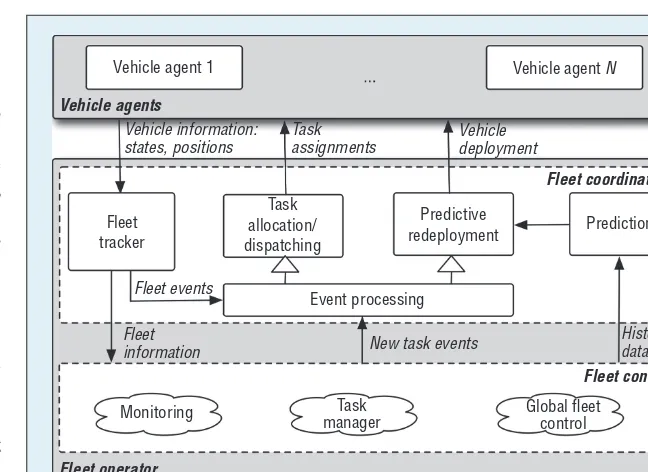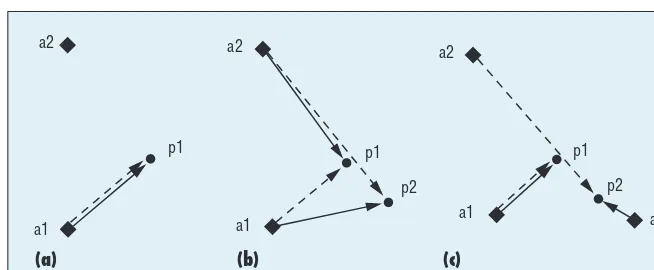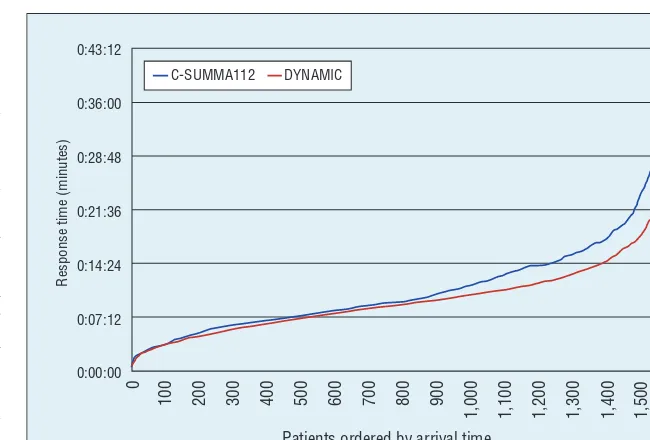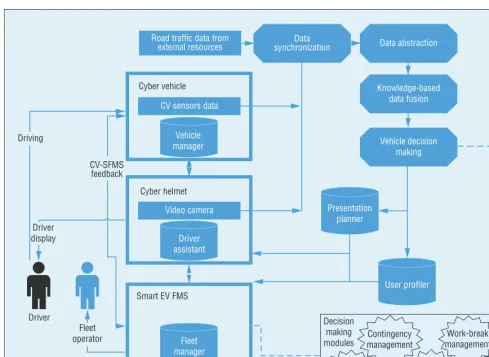I N T E L L I G E N T
T R A N S P O R T A T I O N S Y S T E M S
Editor: Rosaldo J.F. Rossetti, University of Porto, [email protected]
D ynamic Coordination in
Fleet Management Systems:
Toward Smart Cyber Fleets
target-based planning, as well as supervision and control of fl eet operations based on available transportation resources and application con-straints. FMSs have as an objective to reduce risk, increase quality of service, and improve a fl eet’s operational effi ciency while minimizing its costs.1
A key problem in FMS operations is fl eet-route planning, where different transport orders need to be aggregated into tours of fl eet vehicles so that the resulting schedule is both effi cient and robust while meeting the constraints put forward in cus-tomer requests. The main challenge at the tacti-cal level is to support decision making based on seasonality, trends, changing customer mix, and demand. At operational and real-time levels, the challenge is to respond to daily dynamics, such as traffi c, weather, employee absence, equipment breakdown, new orders, and order adjustments.
Approaches to fl eet planning typically focus on the development of near-optimal plans using vari-ous types of effective vehicle-routing algorithms, which can be either static or dynamic.2–4 Fleet schedules designed a priori with static route plan-ning assume the following: all relevant data is
known before the planning starts, short- and long-term decisions have the same importance, and the time available for creation, verification, and implementation of route plans is of minor impor-tance. The use of an initial fl eet schedule, although necessary, is by no means suffi cient because it might not cope adequately with unexpected events dur-ing execution, such as traffi c delays, vehicle break-downs, road works, and new customer requests or the cancellation of preexisting ones, which causes fl eet delays, unexpected costs, and poor customer service. Real-time dynamic FMSs are needed to handle unexpected events—that is, to detect de-viations from the initial dispatch plan and adjust the schedule accordingly by suggesting effective re-routing immediately. In this context, timely deci-sions are very important because the time available for verifi cation, correction, and implementation of changed route plans is often very short.5,6
Real-time FMSs have been applied to a broad va-riety of domains, including emergency vehicles (fi re trucks, ambulances, and so on), police cars, taxis, commercial delivery vehicles, courier fl eets, public transport fl eets, and freight railcars.7–11 However, state-of-the-art FMS solutions are centralized and require vehicle fl eet operators to send low-level commands remotely to the fl eet’s drivers and their vehicles. Even though some dynamics of the envi-ronment are accounted for, certain decisions can’t
“F
leet management system” (FMS) is a termused for a wide range of solutions for dif-ferent fl eet-related applications in the fi elds of trans-portation, distribution, and logistics. It comprises
Holger Billhardt, Universidad Rey Juan Carlos Alberto Fernández, Universidad Rey Juan Carlos
Lissette Lemus, Artificial Intelligence Research Institute, Spanish National Research Council Marin Lujak, Universidad Rey Juan Carlos
Nardine Osman, Artificial Intelligence Research Institute, Spanish National Research Council Sascha Ossowski, Universidad Rey Juan Carlos
be reconsidered because doing so could complicate the assignment pro-cedure and potentially compromise the fleet’s response time. In addition, changes in the environment aren’t al-ways communicated fast enough to FMS operators to help them make de-cisions in a timely manner. The FMS’s dependence on adequate central oper-ator decisions, therefore, compromises its robustness and hinders effective scalability.12
The technological advances in sen-sors, communication and networking technologies, and geographic infor-mation systems enables fleet opera-tors to be informed about unexpected changes in fleet operation almost at the time that they occur, and thus al-lows for increased levels of dynamic-ity in operational decisions. Moreover, the increased performance of small-scale, energy-efficient computing de-vices allows for delegating part of fleet decision making to the fleet’s vehicles, enabling a more decentralized FMS ar-chitecture that gives more autonomy to the vehicles and their drivers and, thus fosters the system’s reactiveness. Here, we sketch our work in the field of real-time FMS and point to devel-opments that we believe are going to take place in the near future. We put forward our vision of conceiving FMS as smart cyber-physical systems, and illustrate the idea in the field of electro-mobility, where drivers of smart e-motorbikes (cyber vehicles),13 equipped with an intelligent commu-nication device (cyber helmet), are coordinated by means of a next- generation FMS.
Dynamic Fleet Management We propose to employ an event-based architecture for dynamic fleet man-agement. We applied this architec-ture to the coordination of a fleet of ambulances in a medical emergency scenario and show experimentally
that our proposal outperforms a non- dynamic approach.
Event-Based FMS Architecture Fleet operators face two main problems: task allocation and redeployment. The allocation problem consists of deter-mining which vehicle should be sent to serve a given task. Redeployment con-sists of relocating vehicles in the region of influence in a way that new tasks can be reached quickly at a low cost. Both issues are particularly challeng-ing in dynamic environments, as con-tinuously arriving new tasks might re-quire attendance, and the fleet’s current situation might change due to external influences. To maximize vehicle utili-zation and improve service quality in such environments, task allocation and vehicle redeployment should also be ac-complished in a dynamic manner, adapt-ing the fleet’s coordination seamlessly to upcoming events and changing de-mands. To adequately capture real-time requirements in such a scenario, we set out from an event-driven approach.14
Figure 1 depicts our architecture for dynamic fleet management. It contains
three basic layers: the top layer con-tains the vehicles, modeled as agents; the second layer represents the fleet co-ordination modules; and the third layer includes other components necessary for normal fleet operation (components for monitoring, task management, global fleet control, and so on).
In the fleet coordination layer, a fleet tracker follows the vehicles’ op-erational states and positions. (We assume that vehicles have the abil-ity to send their current positions on a regular basis and to inform about changes in their operational states.) The fleet tracker informs the event-processing module about any changes in the fleet that would require an ad-aptation of task allocations or the de-ployment of idle vehicles. If necessary, it triggers task allocation and predic-tive redeployment modules. The task allocation module, when executed, recalculates the optimal global as-signment of all pending tasks (in the current moment) to vehicles based on a set of assignment criteria (depending on application domain). The predictive redeployment module
Vehicle agent 1 Vehicle agent N
Fleet
information New task events
Historical
calculates adequate positions for all idle vehicles at the current moment, taking into account predictions con-cerning the appearance of new tasks (based on historical data) and the fleet’s current state.
Case Study: Ambulance Coordination in Madrid
To test our approach, we applied the architecture in a system for coordi-nating a fleet of ambulances for the Emergency Medical Assistance Service, SUMMA112 (www.madrid.org/cs/ Satellite?pagename=SUMMA112/Page/ S112_home), in Madrid, Spain—a re-gion of about 8,000 km2 with approx-imately 6 million inhabitants. Among other services, SUMMA112 maintains a fleet of ambulances that provides out-of-hospital assistance to patients in cases of emergencies. One of the main goals is to reduce response time (the time be-tween when a patient calls and the moment the ambulance arrives) in life- threatening emergencies: shorter re-sponse times are directly correlated with lower mortality rates.
SUMMA112 currently employs a static approach to patient allocation and ambulance redeployment: calling patients are classified by a triage sys-tem into different severity levels, and patients at the highest level are as-signed using the first-come/first-served (FCFS) principle—that is, the first pa-tient in the system is assigned first,
then the next patient, and so on. In each case, a patient is assigned to the closest available ambulance at that particular moment. After an ambu-lance has finished a mission, it returns to its base station and waits for a new assignment. The locations of ambu-lance base stations are fixed and have been chosen based on criteria such as population density and infrastructure.
Based on the architecture presented in Figure 1, we developed a proto-type of a dynamic ambulance FMS in which ambulances and calling pa-tients are the vehicle agents and new tasks, respectively. We concentrated only on the most severe emergency cases, those that are assisted with ad-vanced life support units. Regarding the assignment of patients to ambu-lances (task allocation), we substitute the current static FCFS strategy with a reactive method in which existing assignments can be reconsidered on the fly. As Figure 2 illustrates, any pa-tient who was already assigned to an ambulance might be reassigned to an-other one if this improves the average response time. In particular, a given assignment is recalculated if a new pa-tient has appeared (see Figure 2b) or an ambulance has finished a previous mission (see Figure 2c). For this pur-pose, we used Dimitri Bertsekas’s auction algorithm,15 which assures an assignment that minimizes the key performance indicator (average
ambulance response time) in a suffi-ciently fast manner.
With respect to ambulance rede-ployment, we use historical data to estimate the probability distribution of emergency cases in the region for different days and times of day (one-hour intervals). Based on this estima-tion, we calculate adequate waiting positions for all ambulances that are idle at a given moment. The waiting positions are dynamically recalculated if one of the following events occurs: an ambulance previously assigned to a patient becomes idle again (the mis-sion is finished or the ambulance is de-assigned from a patient), an idle ambulance is assigned to a patient, or a different estimation of the prob-ability distribution needs to be ap-plied (every hour). We implemented the redeployment module based on the calculation of centroidal Voronoi tessellations, a geometric optimization technique that allows to estimate sub-optimal positions of a set of genera-tor points in an Euclidean space and such that the weighted distance of all points in the space to the closest gen-erator is minimized.16
To evaluate our dynamic approach’s effectiveness, we tested it in a set of experiments analyzing the response times to emergency patients. For this purpose, we developed a simulation tool for emergency medical assistance (EMA) services, covering the whole as-sistance process—the emergence of pa-tients, the schedule of an ambulance, the “in situ” attendance, and finally, the transfer of patients to hospitals—based on the information obtained from a well-calibrated, external route service. In our experiments, we considered a rectangle of 125 × 133 kilometres that covers the whole area of Madrid. We used 29 hospitals (all located at their real positions) and 29 ambu-lances with advanced life support (as currently used by SUMMA112). We a2
simulated the operation of the service for 10 different days (24-hour peri-ods) with real patient data from 2009 provided by SUMMA112. We chose the days that gave us a good repre-sentation of high, medium, and low workloads.
Figure 3 compares the distribution of the response times in minutes over all patients (1,609 in total) for both the current FCFS coordination model (C-SUMMA112) and our dynamic co-ordination model (DYNAMIC). The results clearly show the benefits of our dynamic approach, which performs better for practically all response time ranges. Furthermore, the most impor-tant improvements can be observed in the ranges of higher response times. This is an important advantage, be-cause it assures that more patients can be attended within given response time objectives. On average, the re-sponse times are 15.8 percent bet-ter in the DYNAMIC approach (9:54 versus 11:45 minutes). Especially in severe cases, a reduction of almost 2 minutes can be potentially lifesaving.
Toward Cyber Fleets
Prototypes of autonomous vehicles have been designed and tested, with the main challenges related to this new technology currently being stud-ied in countless realistic and complex scenarios (www.cybercars.org).17 At some point, this poses new challenges to FMSs as they attempt to manage fully autonomous vehicles in a decen-tralized manner. Based on currently available technologies, we’re studying the impact of different types of sensors and driver assistance technologies on fleet management. In particular, with the goal of improving the efficiency, safety, and autonomy of vehicle fleets and their drivers, we propose an FMS as a smart, cyber-physical system (cy-ber fleet) made of cy(cy-ber vehicles and drivers with cyber interfaces. In such a
scenario, FMS decision making takes place both at the vehicle level (the drivers interact with their own and other cyber vehicles through cyber interfaces), as well as at the system level, where fleet operators can focus on more coarse grained management decisions for fleets that are potentially heterogeneous and large scale.
Figure 4 outlines our proposed FMS-based cyber fleet. The coordination cloud is similar to the dynamic FMS outlined in Figure 1, but many low-level events can be coped with locally in the cyber vehicles. That is, manage-ment and monitoring tasks are shared between the fleet operator and the cy-ber vehicles with their drivers.
We can illustrate the notion of cy-ber fleets through an example in the field of electro-mobility. The company GoingGreen (www.goinggreen.es), for instance, is deploying fleets of e-motorbikes in the city of Barcelona for vehicle sharing and home de-livery purposes. The cyber fleet of e-motorbikes that we propose comprises three main components: cyber helmet (CH), cyber e-motorbike (CeM), and smart e-motorbike FMS (SeM-FMS).
Smart helmets are currently finding their way into the market (see Figure 5). However, the CH for a cyber fleet of e-motorbikes needs to go beyond the state of the art, insofar as it serves as a smart communication bridge be-tween the driver and the vehicle, and between the driver and the SeM-FMS. For this purpose, it’s equipped with additional communication outlets, a stereo camera, and a microphone, and it’s connected to the CeM to take ad-vantage of its computing capacity.
The interaction between the CH and the driver has to be grounded in situational awareness: the former should refrain from communicating with the driver during difficult ma-neuvering operations or traffic situ-ations, which require the driver’s full attention. In particular, a traf-fic evaluation module ought to take into account traffic images received through the camera, the driver’s cur-rent maneuvering complexity based on the CeM’s GPS coordinates and the actual traffic state, weather con-ditions, the road infrastructure com-plexity, and CH sensor readings about the CeM’s current state (acceleration, 0:43:12
0:36:00
0:28:48
0:21:36
0:14:24
0:07:12
0:00:00
Patients ordered by arrival time
Response time (minutes)
0
100 200 300 400 500 600 700 800 900
1,000 1,100 1,200 1,300 1,400 1,500 1,600
C-SUMMA112 DYNAMIC
velocity dynamics, wheel orientation, and so on). The identification of the traffic situation is possible through image recognition, fusion of data re-ceived from different helmet and ve-hicle sensors, and sensor knowledge extraction. In addition, the CH can determine the mode of communica-tion (audio communicacommunica-tion through microphone, video presentation of data on the helmet’s augmented real-ity display, or a combination of both) and inform the driver about his or her tasks, as well as CeM and traffic
conditions (malfunctions, battery, driving performance, security alerts, weather, traffic accidents, traffic jams, alternative routes, and so on).
The e-motorbikes that GoingGreen currently deploys (see Figure 6) are al-ready equipped with simple sensors and basic data-processing capacity. We can enhance them with additional data sources such as accelerometer, prox-imity (laser) sensors, stereo cameras, and so forth, and will turn them into a CeM by endowing them with ad-ditional computing power. With this configuration, the CeM will perform
real-time sensor data extraction, fusion, and reasoning, and communicate with the driver through the CH connected to the vehicle’s battery and to the SeM-FMS through standard wireless com-munication. Some of the exemplary vehicle processes are forecasting the residual battery autonomy with a spe-cific driver profile, maintaining a driver profile based on driving habits, and networking with other vehicles and SeM-FMSs in the system for task and work break distribution, contingency coverage, and so on. The CeM assists decision making about the mission’s execution. It might receive and directly execute commands from the SeM-FMS about maximum speed limit, maximum acceleration, and engine blocking, so as to enhance energy efficiency and ve-hicle security. But it can also suggest directly to the driver information such as the most adequate charging spots.
The SeM-FMS is the computational platform that ultimately satisfies fleet objectives. Its level of decentralization in decision making is customizable to the fleet owner’s preferences and Weather
forecast
Sensors
Event processing
Local decision making
Traffic
info
Monitoring Task
manager Fleet
information Task events Control events
Global fleet control ...
External services
Fleet operator
Cybervehicle
Cybervehicle Cybervehicle
Cybervehicle
Cyber interface
Fleet coordination
Cybervehicle
Fleet control
Figure 4. Structure of our fleet management system (FMS) for cyber fleets. The coordination cloud is similar to the dynamic FMS outlined in Figure 1, but many low-level events can be coped with locally in the cyber vehicles.
Microdisplay
Electronic main board
Earphone
Battery
Moto helmet with navigation
Microphone Light sensor
Figure 5. Smart motorbike helmet designed by the Russian company LiveMap (https://livemap.info).
constraints; it can vary from a fully centralized to a subsidiary option (see Figure 7). Subsidiarity is an organiz-ing principle of decentralisation, pro-moting the delegation of responsibil-ities to the smallest, lowest, or least centralized authorities capable of ad-dressing an issue effectively (in our case, drivers and their CeMs).18 In a centralized structure, all decisions re-garding a fleet’s strategic, tactical, and operational levels related to task al-location, vehicle deployment, battery autonomy, work break, and contin-gency management are controlled by the central fleet operator. In contrast, with fully decentralized control, the fleet operator only controls the overall fleet strategy (its mission and related
constraints); CeMs manage key parts of mission execution and related op-erations at tactical and operative lev-els in real time through lateral inter-actions. Besides constraints emanating from the concrete organizational en-vironment in which the SeM-FMS is embedded, the fleet’s level of decen-tralization depends, for instance, on its size and dispersion over one or more regions of interest. To facilitate individual accounting for fleet perfor-mance, one of the tools for mission evaluation track’s a personal driver profile record. If necessary, the SeM-FMS can undertake corrective actions on fleet vehicles and drivers to mini-mize performance degradation during sudden performance variations.
W
e plan to further explore cy-ber fleets of e-motorbikes in two case studies with GoingGreen. In home delivery, the task of electric motorcy-cles is to distribute products in an ur-ban area by assigning CeMs to prod-uct pick-up and delivery tasks. The vehicle-sharing scenario refers to a type of vehicle rental for short periods of time, often a matter of hours. The principle of vehicle sharing is that in-dividuals gain the benefits of private transportation without the costs and responsibilities of ownership. Instead, a private user accesses a fleet of ve-hicles on an as-needed basis. We also plan to integrate both business cases into one business solution, where a fleet of CeMs serves both purposes atRoad traffic data from external resources
Data
synchronization Data abstraction
Knowledge-based data fusion
Vehicle decision making
Presentation planner Cyber vehicle
CV sensors data
Vehicle manager
Cyber helmet
Video camera
Driver assistant
Smart EV FMS
Fleet manager
User profiler
Decision making modules
Contingency management
Task allocation
Vehicle deployment
Battery autonomy
mgmt. Work-break management Fleet
operator Driver
display
CV-SFMS feedback Driving
Driver
the same time, and dynamically and seamlessly adapts to user demands to maximize vehicle utilization and in-crease profit gains. In future work, we also intend to extend our approach to mixed cyber fleets capable of manag-ing heterogeneous fleets of traditional vehicles, cyber vehicles, and fully au-tonomous vehicles.
Acknowledgments
This work has been partially supported by the Spanish Ministry of Economy and Com-petitiveness through the projects “Agreement Technologies” (grant CSD2007-0022; CON-SOLIDER-INGENIO 2010), “intelligent Human-Agent Societies” (grant TIN2012-36586- C03- 02), and “Smart Delivery” (grant RTC-2014-1850-4).
References
1. V. Zeimpekis, G.M. Giaglis, and I. Minis, “Development and Evaluation of an Intelligent Fleet Management System
for City Logistics,” Proc. 41st Ann.
Ha-waii Int’l Conf. System Sciences, 2008; doi:10.1109/HICSS.2008.121.
2. W. Maden, R. Eglese, and D. Black, “Vehicle Routing and Scheduling with Time-Varying Data: A Case Study,”
J. Operational Research Soc., vol. 61, no. 3, 2010, pp. 515–522.
3. D. Mardiasmo et al., “Asset Man-agement and Governance: Analys-ing Vehicle Fleets in Asset-Intensive
Organisations,” Proc. 1st Int’l Conf.
Infrastructure Systems and Services: Building Networks for a Brighter Future (INFRA), 2008; doi:10.1109/ INFRA.2008.5439593.
4. V. Zeimpekis et al., “Dynamic Manage-ment of a Delayed Delivery Vehicle in a
City Logistics Environment,” Dynamic
Fleet Management, Springer, 2007, pp. 197–217.
5. B. Eksioglu, A. Volkan Vural, and A. Reisman, “The Vehicle Routing
Problem: A Taxonomic Review,”
Com-puters & Industrial Eng., vol. 57, no. 4, pp. 2009, pp. 1472–1483.
6. V. Pillac et al., “A Review of Dynamic
Vehicle Routing Problems,” European
J. Operational Research, vol. 225, no. 1, 2013, pp. 1–11.
7. S. Ossowski et al., “Decision Support for Traffic Management Based on Organisational and Communicative
Multiagent Abstractions,”
Transporta-tion Research Part C, vol. 13, no. 4, 2005, pp. 272–298.
8. M.-V. Belmonte et al., “Ontologies and Agents for a Bus Fleet Management
Sys-tem,” Expert Systems with Applications,
vol. 34, no. 2, 2008, pp. 1351–1365. 9. T.G. Crainic, M. Gendreau, and J.-Y.
Potvin, “Intelligent Freight-Transpor-tation Systems: Assessment and the Contribution of Operations Research,”
Transportation Research Part C, vol. 17, no. 6, 2009, pp. 541–557.
10. A. Goel, Fleet Telematics: Real-Time
Management and Planning Of Commer-cial Vehicle Operations, Springer, 2007. 11. J. Andersen, T.G. Crainic, and M.
Christiansen, “Service Network Design with Management and Coordination of
Multiple Fleets,” European J.
Opera-tional Research, vol. 193, no. 2, 2009, pp. 377–389.
12. J.F. Kurose and R. Simha, “A Microeco-nomic Approach to Optimal Resource Allocation in Distributed Computer
Sys-tems,” IEEE Trans. Computers, vol. 38,
no. 5, 1989, pp. 705–717. 13. J. Shi et al., “A Survey of
Cyber-Physical Systems,” Proc. Int’l Conf.
Wireless Communications and Sig-nal Processing, 2011; doi:10.1109/ WCSP.2011.6096958.
14. D. Luckham, Power of Events,
Addison-Wesley, 2002.
15. D. Bertsekas, “The Auction Algorithm: A Distributed Relaxation Method for
the Assignment Problem,” Annals of
Operations Research, vol. 14, no. 1, 1988, pp. 105–123.
16. Q. Du, V. Faber, and M. Gunzburger, “Centroidal Voronoi Tessellations:
Ap-plications and Algorithms,” SIAM Rev.,
vol. 41, no. 4, 1999, pp. 637–676.
17. A. Awasthi et al., “Centralized Fleet Management System for Cybernetic
Transportation,” Expert Systems with
Applications, vol. 38, no. 4, 2011, pp. 3710–3717.
18. S.L. Paterson and D.M. Brock, “The Development of Subsidiary-Management Research: Review and Theoretical
Analy-sis,” Int’l Business Rev., vol. 11, no. 2,
2002, pp. 139–163.
Holger Billhardt is an associate professor in Computing Science and Artificial Intelligence at Universidad Rey Juan Carlos in Madrid. Contact him at [email protected].
Alberto Fernández is an associate professor in Computing Science and Artificial Intelligence at Universidad Rey Juan Carlos in Madrid. Contact him at [email protected].
Lissette Lemus is a project manager at the Artificial Intelligence Research Institute, Spanish National Research Council (CSIC). Contact her at [email protected].
Marin Lujak is a post-doc researcher in the Artificial Intelligence Group at Universidad Rey Juan Carlos in Madrid. Contact him at [email protected].
Nardine Osman is a research fellow at the Artificial Intelligence Research Institute, Spanish National Research Council (CSIC). Contact her at [email protected].
Sascha Ossowski is a full professor of com-puter science and the Director ofe the Centre for Intelligent Information Technologies (CETINIA) at Universidad Rey Juan Carlos in Madrid. Contact him at [email protected].
Carles Sierra is a research professor at the Artificial Intelligence Research Institute, Spanish National Research Council (CSIC). Contact him at [email protected].




